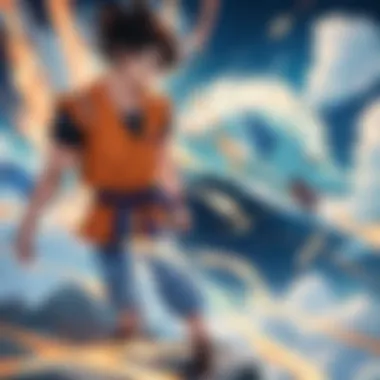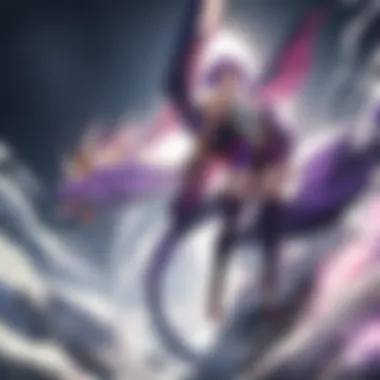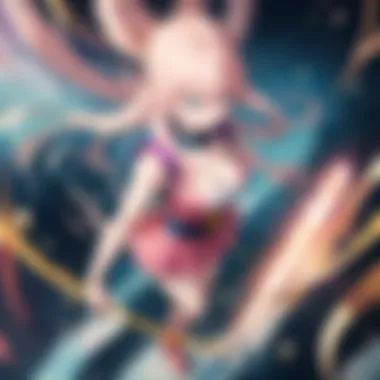Exploring the Depths of Dragon Ball Z: A Cultural Icon


Preamble to the Series
Dragon Ball Z stands as a monumental piece of anime history, captivating audiences since its debut. Released in Japan from 1989 to 1996, it is the sequel to the original Dragon Ball, which itself started in 1986. This series falls under the shonen genre, typically aimed at young males, yet its appeal stretches far beyond demographics. Combining action, adventure, and the themes of friendship and perseverance, Dragon Ball Z has garnered a massive following both in Japan and internationally.
The context surrounding the series’ inception is essential. Created by Akira Toriyama, it builds upon the groundwork laid by its predecessor, while amplifying its scale and stakes. The protagonist, Goku, along with a colorful cast, embarks on epic quests that often involve fierce battles with increasingly powerful foes. This expansion of narrative depth and complexity was a significant shift, situating the anime firmly within the action-oriented storytelling tradition.
The popularity of Dragon Ball Z skyrocketed due to its unique blend of intense battles, character growth, and moral dilemmas. Viewership ratings soared, and the series influenced countless other works within the anime industry. Its arrival in Western markets also solidified its status as a cultural phenomenon, where it became a staple of childhood for many. The impact of Dragon Ball Z can still be observed, evidenced by merchandise, conventions, and a loyal fanbase that continues to engage with the material decades later.
Prelude to Dragon Ball Z
Understanding Dragon Ball Z is essential for anyone who wishes to explore the landscape of anime. This franchise is not merely a show; it is a cultural touchstone that has influenced generations. It encompasses a rich narrative, compelling characters, and themes that resonate universally. Grasping its intricacies prepares one to appreciate its significance fully.
Overview of the Franchise
Dragon Ball Z started as a part of the larger Dragon Ball series, created by Akira Toriyama. It initially aired in Japan from 1989 to 1996. The narrative follows Goku, a Saiyan, as he battles increasingly powerful foes while protecting Earth. The show’s storytelling blends action and emotional depth, offering a refreshing experience for viewers.
The franchise expanded beyond television, spawning movies, merchandise, and video games. Its longevity speaks volumes about its popularity. With every new iteration, it attracts fans, both seasoned and new. Understanding this context is vital for appreciating the evolution of various characters and story arcs.
Significance in Anime Culture
Dragon Ball Z has profoundly impacted anime culture, making it a cornerstone for many fans. It introduced audiences to exhilarating fight scenes and unique character designs, setting standards for future series. Fans often cite it as the gateway anime that drew them into the medium.
Moreover, the franchise has influenced social norms and expectations surrounding storytelling in anime. Themes like friendship, rivalry, and self-improvement are recurrent, encouraging viewers to reflect on relevant life lessons.
"Dragon Ball Z reshaped how shonen anime is perceived today, establishing benchmarks for character development and plot progression."
In modern times, its influence is evident in various realms, from other anime series to western media and pop culture.
In summary, the depth of Dragon Ball Z plays a crucial role in understanding not just the show itself but also its broader impact on anime culture as a whole. The exploration of its elements offers insights into why it remains beloved decades after its debut.
Character Profiles
Character profiles play a crucial role in exploring the depths of any anime series. In the case of Dragon Ball Z, the characters drive the narrative forward and influence the themes presented throughout the series. This section will examine the main characters, their backgrounds, and how they contribute to the franchise's legacy. Understanding these profiles allows for a greater appreciation of the storytelling and character development that defines Dragon Ball Z. It also aids newcomers in grasping the complex relationships and motivations that fuel the plot.
Goku: The Protagonist
Goku stands as the main protagonist in Dragon Ball Z. He embodies the ideals of perseverance and strength. Originating from the Saiyan race, Goku's journey from a naive fighter to one of the universe's most powerful beings illustrates growth and resilience. His innocent nature contrasts with his drive to protect loved ones. Goku's character is a central pillar of the series, as his decisions often propel the story into new challenges. He showcases a fight for justice that resonates with viewers, making him a heroic figure whom fans admire.
Vegeta: The Anti-Hero
Vegeta emerges as one of the most complex characters in the series. Initially introduced as a villain, his character transforms into an anti-hero over time. This complexity adds depth to the narrative. Vegeta's pride and ambition often lead him into conflict with other characters, particularly Goku. However, his journey illustrates themes of redemption and inner conflict. This transformation from enemy to ally provides a compelling arc that enriches the overarching storyline and highlights the struggle for self-improvement.
Supporting Characters
Supporting characters in Dragon Ball Z are integral to its success, each bringing unique traits that complement the main narrative. They enrich the story and provide diverse perspectives, making the world more vibrant.
Piccolo
Piccolo is a unique character who transitions from antagonist to one of Goku's strongest allies. His evolution mirrors the series' theme of redemption. As a mentor to Gohan, his wisdom and tactical prowess become essential in battles. Piccolo is also notable for his strategic mind, which contributes significantly to many fight scenes. His character showcases an important aspect of growth and change within the franchise.
Gohan
Gohan represents the potential of the next generation. As Goku's son, he embodies innocence mixed with immense power. His character development is notable, particularly during the Cell Saga, where he confronts his fears and embraces his Saiyan heritage. Gohan's unique feature is his ability to balance his academic and fighting life, providing a relatable aspect for the audience. His journey often reflects the struggles between family expectations and personal aspirations, making him a character many can connect with.
Trunks
Trunks is significant for his dual identity. He is both the son of Vegeta and Bulma, representing hope for the future. His introduction comes with a dramatic twist, bringing news from a dystopian future that heightens the stakes for the main characters. Trunks’ courage and maturity in confronting powerful foes reveal his growth. His journey adds layers to the narrative, particularly involving his relationship with his father, Vegeta.
Frieza
Frieza is one of the most iconic villains in Dragon Ball Z. His ruthlessness and ambition make him a formidable opponent. Frieza's character enhances the themes of tyranny and power dynamics within the series. His battles push the boundaries of Goku and his friends, demanding they reach new heights to confront evil. This villain not only defines the Frieza Saga but also sets a standard for future antagonists, underscoring the series' commitment to high-stakes conflict.
Cell
Cell represents another vital antagonist, with his complex strategy and abilities. His design reflects the merging of different character traits, which makes him a unique challenge for Goku and his friends. This character enriches the theme of evolution, representing how threats can mutate and adapt. Understanding Cell’s motivations and backstory deepens the appreciation for the narrative and the stakes involved, solidifying his place in the franchise's history.


Plot Overview
The plot of Dragon Ball Z serves as the backbone of the series, weaving together character motives, themes, and grand cosmic conflicts. Understanding the narrative structure deepens one’s appreciation for the development of characters and the significance of encounters throughout the series. Each saga contributes to an overarching narrative that reflects growth, struggle, and transformation. The series explores the consequences of power and the bonds that tie its characters together.
The Saiyan Saga
The Saiyan Saga introduces the core concepts of power and heritage vital to the series. The arrival of Raditz, Goku’s brother, sets into motion a series of events that bring forth significant revelations about Saiyan history and Goku’s true nature. This saga effectively contrasts Goku's simple, wholesome character with the ruthlessness of Saiyan warriors.
Notably, this saga marks pivotal moments such as Goku's death, which serves as a catalyst for character development. Furthermore, the introduction of Vegeta positions him as both a rival and eventual ally. This conflicting dynamic sets the tone for Goku’s ongoing journey.
Key elements of this saga include:
- The introduction of the concept of the Super Saiyan.
- The exploration of family dynamics among warriors.
- The early themes of friendship as seen through Goku’s relationships with characters like Piccolo and Krillin.
The Frieza Saga
The Frieza Saga escalates the stakes introduced in the previous saga. Frieza, as the main antagonist, embodies tyranny and manipulation. The conflict on Planet Namek reveals not only Goku's growth into a formidable fighter but also the extent of Frieza's malevolence. Goku's transformation into a Super Saiyan marks a significant turning point in the series. This transformation symbolizes the triumph of hope and the fight against oppression.
In addition to intense battles, the saga delves into themes of revenge and sacrifice, particularly through characters like Vegeta and Goku. The depiction of the struggle against Frieza makes the emotional arcs of the characters more pronounced. Important aspects of this saga include:
- The resurrection themes tied to the Dragon Balls.
- The dynamics between different races, notably the history of the Saiyans and Namekians.
The Cell Saga
Moving into the Cell Saga, the introduction of the androids and Cell advances the series' narrative complexity. Cell, being the ultimate bio-engineered villain, presents not just a physical threat but a psychological one that challenges the ideals of strength and heroism. The saga questions what it means to be human and the divisiveness surrounding power.
Gohan’s transformation into a Super Saiyan during this saga illustrates the shift in focus from Goku to the next generation. This generational conflict highlights themes of legacy and responsibility. Key highlights include:
- The concept of self-actualization through Gohan’s character arc.
- The moral debates regarding artificial life versus natural existence.
The Buu Saga
The Buu Saga signifies the culmination of character evolution seen throughout the series. The varied forms of Majin Buu present unique challenges, from a comedic outlook to a horror element, making the narrative unpredictable. Goku’s cooperation with other characters epitomizes unity against adversity. This saga showcases the importance of teamwork, as heroes rely on one another to overcome Menacing threats.
The transition from pure combat to a blend of strategy and solace is present, especially through the introduction of new characters and the emotional weights they carry. Key components of this saga include:
- The return of Goku as a guiding figure.
- The exploration of forgiveness as a central theme, especially between Goku and former enemies like Vegeta.
The enrichment of plot throughout Dragon Ball Z is testament to its ability to evolve characters and themes over time. Each saga provides its unique flavor, ensuring that the narrative remains engaging and relevant.
Themes and Motifs
The thematic elements and motifs explored within Dragon Ball Z offer a rich tapestry that extends beyond mere entertainment. Each theme reveals complexities of human emotions and societal values, and thus serves as a vehicle for greater understanding of both characters and plot developments. The exploration of friendship, the relentless pursuit of power, and the contemplation of life and death are foundational threads woven throughout the narrative. This section will delve into these key themes, examining their significance and impact not only on character arcs but also on the broader cultural landscape.
Friendship and Loyalty
Friendship is a central theme in Dragon Ball Z, characterized by moments that showcase the depth of loyalty between characters. The bonds among the Z fighters, especially between Goku and his friends, illustrate how collaboration can strengthen resolve. For instance, during intense battles, characters often rely on each other for emotional and physical support. This reveals a crucial aspect of anime: teamwork is not just advantageous but essential for survival.
Moreover, these friendships underline the importance of camaraderie in overcoming adversity. Goku’s unwavering support for his friends highlights a sense of belonging and trust, which drives the narrative forward. Characters go beyond mere allies; they evolve into family, demonstrating that true power is derived from mutual respect and loyalty.
"The strongest bonds often form in the direst moments, revealing the true nature of friendship."
In essence, the depiction of friendship and loyalty in Dragon Ball Z resonates with audiences, offering a lens through which they can reflect on their own relationships. This theme encourages viewers to consider the moral implications of loyalty and the strength found in unity.
The Pursuit of Power
The relentless quest for power is another key theme within Dragon Ball Z. Characters are often driven by the desire to surpass their limits, reflecting a universal aspiration among individuals. Goku's journey exemplifies this pursuit; each transformation he undergoes signifies not just physical strength but a deeper commitment to personal growth.
However, this pursuit is twofold. While the desire for power can lead to self-improvement, it also raises ethical questions. Characters like Vegeta exemplify the darker side of this quest, revealing how ambition can lead to isolation and conflict. The struggle between light and dark, as seen through various antagonists, showcases power's duality—its potential for good and for harm.
The portrayal of this theme invites viewers to ponder their own motivations. Dragon Ball Z does not merely celebrate strength; it also critiques the unchecked ambition that can lead to destruction. This nuanced exploration of ambition resonates deeply with audiences, who may have experienced similar conflicts in their own lives.
Life and Death
Life and death serve as profound motifs throughout Dragon Ball Z, manifesting in various forms. The series does not shy away from portraying the fragility of life, emphasizing the stakes involved in battles. Characters face mortality on multiple occasions, heightening the tension and emotional weight of each conflict.
The concept of death transcends the physical. It compels characters to reflect on their existence, goals, and relationships. Goku's encounters with deceased friends and foes serve as catalysts for personal growth and understanding. Each defeat is not an end, but rather a transition that shapes the individual’s journey.


This motif invites deep reflection on the values of resilience and transformation. Life and death themes in Dragon Ball Z ultimately urge viewers to consider what it means to live fully, recognize the value of each moment, and understand the inevitable nature of mortality, while also celebrating the bonds that persist beyond death.
Animation and Art Style
The animation and art style of Dragon Ball Z plays a pivotal role in defining its overall appeal and cultural significance. This aspect transcends mere aesthetic considerations, influencing viewer engagement and setting a standard within the anime industry. Through distinctive character designs, dynamic fight sequences, and thoughtful use of colors and forms, Dragon Ball Z captivates its audience in ways that are both memorable and impactful.
Character Designs
The character designs in Dragon Ball Z are instantly recognizable and contribute significantly to the series' identity. Each character is crafted with unique features that convey personality and role within the narrative. For example, Goku's spiky black hair and orange gi symbolize his carefree yet determined nature. In contrast, Vegeta's stern expression and royal attire reflect his prideful, warrior background. These designs help viewers easily associate characters with their traits, enhancing emotional connections.
Additionally, the transition of character designs over the series marks their development. The shifts in armor for characters like Gohan from child to adult highlight their maturation and growth. This evolution not only emphasizes the narrative arcs but also reflects audience attachment to these characters as they evolve alongside them.
Fight Sequences
Fight sequences are integral to the action and narrative momentum of Dragon Ball Z. The choreography combines traditional Japanese anime influences with dynamic motion, creating battles that feel both intense and theatrical. Each sequence integrates various martial arts styles, weaving complex movements that showcase the characters' skills and power levels.
The series uses a technique called speed lines, which visually represents the fast-paced action. This method amplifies the excitement and keeps viewers on the edge of their seats. Furthermore, the strategic use of camera angles during fights increases immersion, allowing audiences to experience the impact of blows and energy blasts firsthand.
Utilization of Color and Form
Color and form in Dragon Ball Z are not just about aesthetics; they amplify themes and emotions throughout the storyline. Vibrant colors are often used to symbolize different characters or power states. For instance, Goku's Kamehameha wave is depicted in bright blue, signifying its significance and energy. In contrast, darker shades often accompany the presence of villains, creating a stark visual dichotomy that highlights good versus evil.
Form also plays a crucial role. The exaggerated features of characters during transformations amplify their power and emotional states. When Goku transforms into a Super Saiyan, the change is not merely physical; the entire animation adapts to communicate intensity through flickering auras and explosive energy.
"The artistry of Dragon Ball Z transcends simple animation; it becomes a visual language that complements the storytelling, deeply resonating with its audience."
Understanding these elements enriches our appreciation of Dragon Ball Z. They create a distinctive experience that leaves a lasting impact. The art style invites fans not only to watch but to feel deeply connected to the saga.
Production Insights
The production insights of Dragon Ball Z are critical to understanding the series' success and longevity. This section highlights the behind-the-scenes elements that shaped the anime, focusing on creators, music, and the cultural impact of the production process.
Creators and Key Staff
Dragon Ball Z is a result of the hard work and vision of talented individuals. Akira Toriyama, the creator of the original manga, laid the groundwork for the anime adaptation. Toriyama's unique art style and storytelling approach contributed significantly to the franchise's identity. Alongside him were notable figures like producer Yoshio Takami and director Daisuke Nishio. Together, these individuals guided the anime from the manga's pages to the television screen.
The synergy between the creators and the staff was crucial. Their collaboration ensured that the essence and excitement of the manga were preserved when adapting it into an animated series. The combination of Toriyama's storytelling with Nishio's direction brought memorable episodes to life.
Music Composition
The role of music in Dragon Ball Z cannot be understated. The series features iconic soundtracks that elevate the emotional weight of pivotal scenes. Composed primarily by Shunsuke Kikuchi, the music largely supplemented the unfolding drama and action sequences. Each character had distinct themes that became synonymous with their presence on screen.
The adaptation of the soundtrack for international audiences also plays a role in the series' reception. Alternative soundtracks, like those from Bruce Faulconer for the English dub, also impacted how fans perceived the show. This difference in musical composition reflects cultural nuances that cater to varying preferences, thus broadening the audience.
Cultural Impact on Production
Dragon Ball Z is not just an anime; it is a cultural landmark. The effects of this series on the production methods and trends in the anime industry are profound. Following its success, many shows adopted similar themes: epic battles, power-ups, and prolonged story arcs that kept viewers engaged.
Moreover, the franchise's popularity led to increased investment in anime production. Consequently, other studios began to focus on high-quality animation and storytelling. Dragon Ball Z set a standard that many sought to emulate, influencing not only anime but also influencing global perceptions of animation.
"Dragon Ball Z not only entertained audiences but reshaped the entire landscape of anime production."
Global Reception
The global reception of Dragon Ball Z is a pivotal aspect of its significance in both anime culture and entertainment in general. Understanding its reception provides key insights into not only the show's popularity but also its lasting impact on audiences around the world. Examining factors such as viewership numbers, critical reviews, and the controversies that surrounded it helps shape the narrative of this iconic series. A deep dive into these elements reveals how Dragon Ball Z became more than just a show; it turned into a cultural milestone that influenced generations.
Viewership and Popularity
From its initial release in 1989, Dragon Ball Z garnered immense viewership across various regions. The series became a defining anime for many fans worldwide. In countries such as Japan, the series achieved high ratings during its broadcast on Fuji TV, often competing with popular local shows.
In the United States, Dragon Ball Z was introduced to audiences on Cartoon Network's Toonami block. It quickly gained a significant following, leading to an increase in viewership that made it one of the first anime series to resonate with Western audiences. This switch from animated programming to a greater appreciation for anime created a subculture that thrives to this day.
Key Factors of Popularity:
- Compelling Story Arcs
- Dynamic Character Development
- High-Intensity Fight Scenes
- Merchandising Impact
The series' global viewership solidified its status as a titan in anime, attracting viewers from different age groups and backgrounds. Not only did Dragon Ball Z perform well in traditional television viewership statistics, but it also became a central piece in conversations and discussions among anime communities.


Critical Acclaim
Critically, Dragon Ball Z received both praise and scrutiny. Many critics noted the show's ability to mix action and emotional narratives, effectively captivating its audience. The intense battles between characters such as Goku and Frieza showcased not only fantastic animation but also significant character development. Critics acknowledged this complexity, giving the series a unique place in anime history.
The animated adaptation has also received favorable reviews from major publications. The score by Bruce Faulconer further enhanced the series' atmosphere, and themes of perseverance and friendship resonated strongly. Such thematic consistency, coupled with strong characters, aimed to engage a wide array of viewers beyond the teenage demographic, appealing to older fans as well.
However, the series also faced its share of criticism. Some reviewers pointed to the pacing issues and filler episodes, suggesting they detracted from the overall narrative arc. Despite these critiques, the acclaim overshadowed the negatives, establishing Dragon Ball Z as a pivotal work in the anime industry.
Controversies and Criticisms
Like many successful franchises, Dragon Ball Z faced controversies and criticisms. The portrayal of violence, especially in fight scenes, often sparked debate regarding its appropriateness for younger audiences. Some parents and educational advocates raised concerns about the influence of these violent displays. However, many fans argue that the combat stylings contribute to the show's themes of growth and struggle, which are integral to the character arcs.
Furthermore, the series’ treatment of female characters often came under scrutiny. Many discussions highlighted a perceived lack of depth or agency for female characters such as Bulma and Chi-Chi, leading to broader discussions of gender representation in anime and the media.
Despite these controversies, the dedication of the fanbase has largely shielded Dragon Ball Z from severe backlash. In this way, while criticisms are important to acknowledge, the overall contribution of the series to anime remains influential and significant.
"Dragon Ball Z is a lens through which we can understand evolving anime culture and discourses around media consumption."
Merchandising and Legacy
The success of Dragon Ball Z extends beyond its narrative and animation. The merchandising and legacy of the series play a crucial role in solidifying its status in anime history. Merchandise allows fans to express their connection to the show. It also generates significant revenue for the franchise, ensuring its ongoing presence in both entertainment and popular culture. Understanding this relationship helps us appreciate how Dragon Ball Z transcended its roots as a show, evolving into a multifaceted cultural entity.
Action Figures and Collectibles
Action figures and collectibles are among the most popular merchandise related to Dragon Ball Z. Companies like Bandai and Funko produce high-quality figures that attract collectors and fans alike. These items range from highly detailed replicas of characters such as Goku and Vegeta to exclusive limited-edition releases that hold significant value over time.
In addition to the aesthetic appeal, collecting these figures creates a sense of community among fans. Many enthusiasts share their collections online, providing a platform for interaction and discussion. This community-driven experience enhances the connection fans feel toward the series, as they bond over shared interests.
Some key elements of this segment include:
- Variety: Figures available include standard display models and dynamic poses.
- Accessibility: Most figures can be found at various price points, appealing to a wide audience.
- Trade and Exchange: Platforms like eBay and local conventions facilitate trading, helping collectors expand their trove.
"The collectible value of Dragon Ball Z action figures illustrates the enduring appeal of the series, inviting both nostalgia and investment among fans."
Video Games
Video games also contribute to the franchise's legacy. Series like Dragon Ball FighterZ and Dragon Ball Z: Kakarot appeal to both gamers and anime fans. These games not only allow players to engage with the storyline but also to experience the fighting mechanics that define the series. The gameplay often reflects key moments and battles from the anime, enhancing immersion.
The ongoing expansion of the gaming universe reinforces Dragon Ball Z's presence in modern pop culture. Each new release tends to generate significant buzz and anticipation, ensuring that even younger audiences become aware of the franchise. Important aspects include:
- Diverse Genres: From fighting games to RPGs, the range of genres caters to various preferences.
- Multiplayer Experience: Many games encourage collaboration and competition between players.
- E-Sports: Competitive gaming events often feature Dragon Ball Z titles, drawing in large audiences and fostering a competitive scene.
Cultural References in Other Media
Dragon Ball Z's influence extends into various forms of media beyond anime. It has been referenced and parodied in shows like The Simpsons and South Park, showing its relevance in popular culture. This acknowledgment from mainstream media highlights the series' impact and familiar status in entertainment.
Additionally, Dragon Ball Z has inspired numerous creators. Various manga and anime series list it as a significant influence. This extends to artists, musicians, and filmmakers who incorporate elements from the series into their work. Key points about its cultural references include:
- Cross-Platform Influence: The series is recognized in movies, television, and music.
- Recognition: Awards and accolades often reference the show's legacy during discussions.
- Fan Art and Cosplay: Inspired by the series, fans actively create costumes and art, showcasing the story's reach.
In summary, the merchandising and legacy of Dragon Ball Z not only reinforce its place in anime history but also demonstrate its broad appeal across generations. Fans today continue to find joy in both collecting merchandise and engaging with the series through various media formats.
Culmination
The conclusion of this article synthesizes the various aspects of Dragon Ball Z, highlighting its importance and enduring legacy in the anime realm. This iconic series stands as a landmark in storytelling, animation, and character development. The series has not only entertained millions but also shaped cultural dialogues worldwide. With its gripping narratives and complex characters, Dragon Ball Z has engaged audiences across generations.
Summation of Key Points
In summary, the article covered multiple facets of Dragon Ball Z:
- Character Complexity: Goku, Vegeta, and supporting characters display significant growth. Their journeys expand themes of friendship, struggle, and redemption.
- Narrative Arcs: Each saga—Saiyan, Frieza, Cell, and Buu—offers a distinct narrative that delves into the complexities of power and morality.
- Cultural Impact: Beyond being a mere cartoon, Dragon Ball Z brought anime to the forefront of global pop culture. It influenced not only viewers but also countless artists and creators.
- Production Insight: The collaborative effort of talented creators and musicians crafted the memorable experiences integral to the show’s success.
Through its multifaceted nature, Dragon Ball Z represents a significant cultural artifact, opening avenues for discussions around animation and storytelling.
Future of the Dragon Ball Franchise
Looking forward, the future of the Dragon Ball franchise appears promising. Recent developments, such as the continuation of Dragon Ball Super, show that there is a persistent demand for the adventures of Goku and his friends. Here are some considerations for the future:
- New Story Arcs: Fans are eager for fresh narratives that explore untapped character backgrounds and new elements of the Dragon Ball universe.
- Technological Advances: Improved animation techniques could enhance the visual storytelling, making fight scenes more dynamic and engrossing.
- Cultural Adaptations: As global interest in anime expands, Dragon Ball Z could further influence international media, leading to adaptations, merchandise, and collaborations.
"Dragon Ball Z remains not just a nostalgic memory, but a living franchise ready to evolve with its audience's expectations."
The franchise's resilience lies in its ability to blend tradition with innovation. This approach ensures that Dragon Ball Z will continue to resonate with both longtime fans and newcomers alike.















